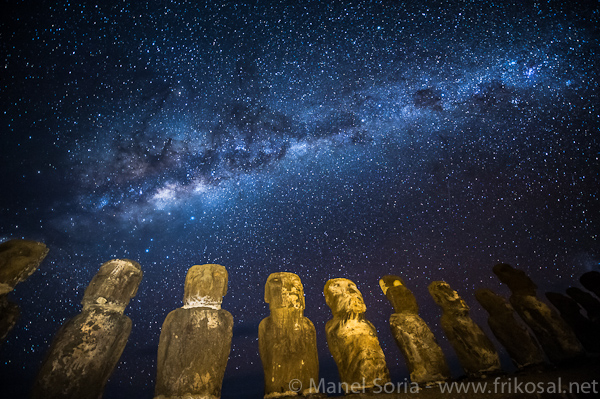ARCHAEOASTRONOMY – THE COSMIC LANDSCAPE
These famous words uttered by the late Carl Sagan, may be
considered to be the precursor of numerous enthusiasts to understand the universe
and in turn to understand ourselves. The discipline of Archaeoastronomy
does exactly this, it tries to understand how early humans made sense of the
sky and the cosmos, and in turn decode certain secrets of our evolution.

Celestial events thus had great
influence over the daily lives of ancient humans. Time, for example, was referenced
with predictable cycles of certain stars, the sun, the moon and even planets (the months in the Mesopotamian
calendar, for example, was based on the lunar cycle). Afterlife, a
structural component of any worldview, was attributed to certain cosmic events,
as seen in the Mayan tomb of King Pacal in the Maya site of Palenque, where the
King is placed at the solstitial point, which marks the resumption of the solar
cycle and the start of agricultural activities, thus symbolising his rebirth
after death.
 |
| The lid of Pacal's sarcophagus |
This bond between the apparent cosmic
beings and nature was ideological and intangible, which gave rise to the need
to reform this cosmic vision into tangibility. This stemmed the emergence of
monumental architectural structures which symbolised a material form of the
cosmic cycles for the common people. These structures closely followed
astronomy and could be understood with the concept of hierophany. An
explicit manifestation of the sacred, hierophanies were the means of communication
with the divine. They were sacred spaces that amalgamated celestial cycles and
cosmic events with religious and mythological models which were engineered
using the knowledge of astronomy. These structures are mechanisms where elements,
that are designed with utmost precision, combine with celestial elements. When
put together with religious connotations the events occurring in these
hierophanies are considered divine manifestations. For example, the alignment to
the sunrise on the winter solstice of Karnak’s temple in Egypt and the Serpent
Equinox at Chichen Itza are manifestations of the renewal of a god’s power with
the celestial cycles. The alignment of Newgrange and the Akhet hierophany at
Giza symbolize the renewal relating to the afterlife.
 |
| Serpent Equinox at Chichen Itza. The shadow of the rising sun forms the body of the serpent. |
Sacred spaces are associated with
cultural memory i.e., once a place is deemed sacred, the community strives
towards maintaining its divinity over time. This results in the modification,
reconstruction and reinterpretation of that place according to the ruling
community overtime resulting in the formation of a cosmic landscape, that
merges the religious elements with the natural surroundings, which is enhanced
by human construction following specific rules in accordance with the worldview
(topographical and/or astronomical rules) which were passed on through
generations. The Balamkanchè cave of the Yucatan, is a huge cave which has a
naturally occurred column created by the joining of a stalactite and stalagmite
over years of water percolation. Its resemblance to the sacred Maya tree,
Ceiba, turned the cave into a shrine where people brought offerings. The giant “footprints
of the sun” at Island of the Sun on the Titicaca Lake, where the Incas
considered they originated from, were natural etchings which resembled
footprints were deemed sacred as it lay near the rock where apparently the sun
itself was born. The city of Teotihuacan in Mexico, the largest urban settlement
of Mesoamerica, which fell after surviving five centuries and then centuries
later was discovered by the Aztecs who called it “the place where the gods were
born”. The two pyramids in the city, the Pyramid of the Sun and the Pyramid of
the Moon, bear uncanny resemblances to the profiles of two mountains in the
north when viewed from a certain point. Thus, the architects of the city aimed
at replicating the mountains of their cosmic landscape. The city also bears astronomical
connotations, the main street of the city is skewed at an angle in relation to
true north. This results in the street aligning with the rising and setting of
the sun on two specific days of the year which are 260 days apart, a number
that is recurrent in Mesoamerican calendars and associated with agricultural
activities. Thus, the cosmic landscape comprises of geographical, architectural
and astronomical elements which result in extremely complex sites.
 |
| Schematic plan of Teotihuacan: 1 Main ceremonial road. 2 Pyramid of the Moon. 3 Pyramid of the Sun. 4. Ciutadela temple |
Although, there has been numerous insane explanations to these complex ancient sites that resemble the cosmos, archaeoastronomical studies conducted by archaeologists, anthropologists and astronomers has provided significant insights in decoding the secrets of such sites. The discipline of archaeoastronomy has much more to offer which we will be covering in later posts.
Further Readings
Magli, G. (2015). Archaeoastronomy:
Introduction to the Science of Stars and Stones. Germany: Springer
International Publishing.
Milone, E. F., Kelley, D. H. (2005). Exploring
Ancient Skies: An Encyclopedic Survey of
Archaeoastronomy. Netherlands: Springer New York.
Ruggles, C. L. N. (2005). Ancient Astronomy: An Encyclopedia of Cosmologies and Myth. United States: ABC-CLIO.

.png)

Very interesting. Love it
ReplyDeleteEngrossing
ReplyDelete